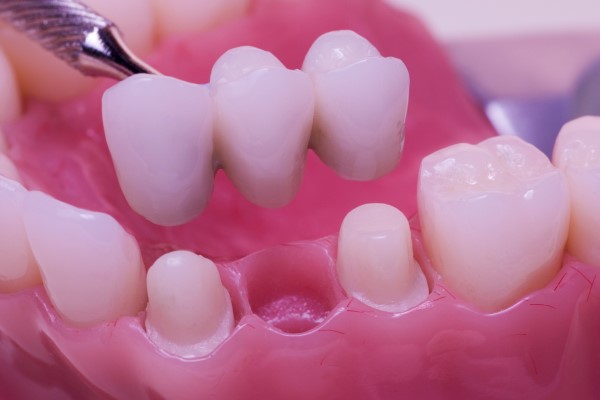Pros and Cons of Dental Bridges

A dental bridge might be recommended for you if you are missing one to three teeth in a row. As their name implies, these oral prosthetics bridge the space left by missing teeth with artificial ones. They are typically made up of two main components: abutments (crowns) used to anchor the appliance and pontics (artificial teeth) that fill up the spaces left by missing teeth.
A dental bridge does not only bridge the space left by missing teeth. It also bridges the difference between implants and dentures. In terms of missing teeth replacement options, implants are the closest thing to real teeth, but they are the most expensive option. Dentures are the most affordable option, but they do not feel as natural as implants.
Bridges are somewhere between these two devices. They are not as expensive as implants, but they feel more natural in the mouth than dentures.
Things to consider before getting a dental bridge: Pros and cons
Thinking about replacing your missing teeth with a bridge? Let's go over their pros and cons so you can make an informed decision.
Pros
Some of the benefits of choosing dental bridges over other missing teeth replacement options include:
- Does not require surgery: Unlike implants, replacing missing teeth with bridges does not require oral surgery. The only exception would be for an implant-supported bridge
- Faster teeth replacement compared to implants: The traditional process of getting a dental bridge takes about the same time as it does to get dentures: about two weeks. Getting implants can take as long as six months since bone tissues around the restoration need to fuse with it
- More affordable than implants: Implants are the priciest way to replace missing teeth. A single implant typically costs more than a bridge used to replace multiple teeth. Dental bridges are more expensive than dentures, but many patients find the extra costs worth it given the improved comfort and function of bridges
- Improved stability over dentures: Dental bridges are significantly more secure in a patient’s mouth than dentures. Dentures are known to shift in the mouth even when nasty-tasting dental adhesives are used. They are also known to fall out of the mouth when eating or speaking. Just imagine how embarrassing that would be in public. Bridges, on the other hand, are anchored down to crowns placed on the teeth closest to the gap, so they do not move in the mouth, making them feel more natural
Cons
There is no such thing as a perfect dental restoration, and bridges are not an exception. Some of the disadvantages of dental bridges include:
- Installation sometimes requires altering healthy teeth: Dental bridges are typically anchored down to the teeth closest to the space left by missing teeth. These teeth are usually covered up with crowns to provide better stability for the bridge. The placement of crowns involves removing enamel from teeth to create a better fit. This is a permanent change that cannot be reversed in the future, meaning the teeth will always need crowns to serve as their artificial enamel moving forward
- Bridges do not stop bone loss deterioration: Bone tissues in the jaw need regular stimulation to remain healthy just like muscles in the body. They lose this stimulation when teeth fall out, leading to bone tissue breakdown. This can lead to changes in a person’s facial structures and the formation of wrinkles and fine lines. Bridges do not help to prevent this bone tissue breakdown like implants do
- Bridges do not last as long as implants: Implants are usually made out of titanium and are designed to last a lifetime. The only thing people with implants might have to change at some point is the crown that sits on the implant to replace a missing tooth. These crowns last up to 25 years, while bridges only last about 15 years
- Pricier option than dentures: If saving money is high on a patient’s priority list, dentures are the more economical option. Dentures are nowhere as comfortable as bridges, but they do replace missing teeth
What to expect when getting dental bridges
Getting dental bridges usually involves patients sitting in a dental chair while a dentist injects them with a local anesthetic to start the procedure. The teeth that will be used as abutments are prepared by removing enamel from them or filling up hollow areas.
A rubber mold is used to make an impression of the gap in the patient’s smile and the teeth around it. The impression is sent to lab technicians who make oral prosthetics in a lab. It takes about two weeks for the finished product to get back to the dentist.
The patient gets a temporary bridge while they wait for their custom appliance. During the second appointment, the temporary bridge is removed and replaced with the customized bridge to complete the treatment.
Restore your smile with a bridge
Tired of having a gap in your smile? A dental bridge might be your best option. Call or stop by our Marietta location for a consultation.
Request an appointment here: https://www.mytotaldentistry.com or call McCarthy Dentistry at (740) 546-5178 for an appointment in our Marietta office.
Check out what others are saying about our dental services on Yelp: Dental Bridges in Marietta, OH.
Recent Posts
Think you might need a dental bridge? Read on to learn more about this restoration. According to the National Institute of Craniofacial and Dental Research, adults aged 20–64 have an average of three decayed or missing teeth. A dental bridge is among the most important restorative dentistry procedures, helping to restore optimal dental health and…
A dental bridge, sometimes described as fixed partial dentures, is a type of dental restoration that replaces one or more missing teeth. Dental bridges are made of porcelain or other materials. The tooth or teeth on either side of the gap are prepared to receive crowns and false teeth (known as pontics). The false teeth…
Along with other treatments, a dental bridge is a common way to improve a smile and help you feel better about your appearance. This procedure can replace missing teeth and close embarrassing gaps in your mouth. If you undergo this process, you can have less anxiety in social situations and want to open your mouth…
Curious about whether you need a dental crown after a root canal? Read on to learn more. Many patients believe that a root canal is a painful procedure and therefore avoid it. In cases of seriously damaged or infected teeth, root canals are the last resort to prevent an extraction. After the root canal treatment,…


